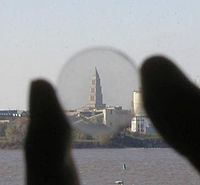
Photo from wikipedia
Abstract Near-surface geophysical methods such as Semiconductor LASER Light Box (SCLLB) and Proton Precession Magnetometer (PPM) coupled with Vertical Electrical Soundings (VES) and water dowsing approach are used to measure… Click to show full abstract
Abstract Near-surface geophysical methods such as Semiconductor LASER Light Box (SCLLB) and Proton Precession Magnetometer (PPM) coupled with Vertical Electrical Soundings (VES) and water dowsing approach are used to measure the vein width of Groundwater (GW) on the Earth's surface at fifteen locations in the Deccan Trap flood basalt area in Pune region, Maharashtra, India. The main objective is to validate old simple water dowsing way of GW detection in hard rock using the established modern science and technology namely VES, PPM and SCLLB techniques. On the basis of deflection of the L-shaped copper rods, the presence of GW with clues on the edges of GW vein is detected using the old traditional dowsing method. The efficacy of dowsing is verified by VES. It is found that apparent resistivity in the range from 48Ωm to 117Ωm over the GW location delineated by the dowser is relatively low, thus confirming the presence of GW in the study area. Variation in the intensity of Earth's Magnetic Field (EMF) measured by PPM is found in the range from 37,788nT to 43,242nT over GW locations. High magnetic intensity values indicated high GW potential in weathered vesicular-amygdaloidal basalt and magnetic field gradient changes enabled to calculate GW vein width. It is suggested that water dowsers might get a dowsing reaction as a result of entering into magnetic field gradient changes caused by GW. Digital barometer records the atmospheric pressure (P) and temperature (T) showing that both P and T are higher than the non-GW location which alters refractive index (RI) of medium over GW locations in the study area. A small change in RI alters the intensity of the semiconductor laser beam (≈234 μA to 1204 μA) indicating the edges of GW vein, thus giving the width of the vein. The results obtained by PPM and SCLLB match with dowsing responses. It is found that GW sources and width of GW vein (≈1 m to 6 m) in Deccan basaltic terrain can be measured quickly and with ease by using SCLLB in comparison to VES and PPM. It is concluded that the application of proposed modern instrumental measurement survey by PPM and SCLLB coupled with the old simple technology of water dowsing demonstrated the potential to generate a subsurface water resource database at the national level, especially in hard rock.
Journal Title: Journal of Applied Geophysics
Year Published: 2019
Link to full text (if available)
Share on Social Media: Sign Up to like & get
recommendations!